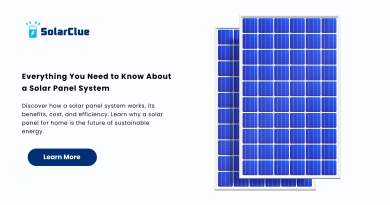Will The Price Of Solar Panels Go Down?
Solar panel prices have significantly fluctuated over the years, driven by technological advancements, manufacturing costs, supply chain dynamics, and government policies. As India and the world increasingly embrace renewable energy, understanding the factors that influence solar panel pricing and predicting future trends is crucial for consumers, businesses, and policymakers.
Table of Contents
- 1 Historical Trends in Solar Panel Prices
- 1.1 Factors Affecting Solar Panel Costs
- 1.2 The Role of Technology in Driving Down Prices
- 1.3 Impact of Government Policies and Subsidies
- 1.4 Supply and Demand Dynamics in the Solar Market
- 1.5 Price Predictions for the Future
- 1.6 The Relationship Between Solar Panel Prices and Overall System Costs
- 1.7 Consumer Implications of Fluctuating Solar Panel Prices
- 1.8 The Impact of Solar Panel Prices on Market Adoption
- 1.9 Strategies for Maximizing Savings on Solar Panel Purchases
- 1.10 Factors Influencing Solar Panel Prices
- 1.11 FAQs
Historical Trends in Solar Panel Prices
Solar panel prices in India have dramatically declined over the past few decades. In the early 2000s, the cost of solar panels was around ₹300 per watt. By 2023, prices have dropped to approximately ₹15 to ₹25 per watt, driven by improvements in technology, economies of scale, and increased competition.
| Year | Price per Watt (INR) |
|---|---|
| 2000 | ₹300 |
| 2010 | ₹100 |
| 2020 | ₹20 – ₹30 |
| 2023 (Estimate) | ₹15 – ₹25 |
Factors Affecting Solar Panel Costs
Several factors influence the cost of solar panels, and understanding these can help predict future trends:
1. Technological Advancements: Innovations in solar cell efficiency, materials, and manufacturing processes continue to reduce costs.
2. Manufacturing Costs: Advances in automation, scaling up production, and sourcing cheaper raw materials have driven down costs.
3. Supply Chain Dynamics: Global supply chain disruptions, such as those seen during the COVID-19 pandemic, can temporarily increase prices.
4. Government Policies and Subsidies: Incentives like tax credits and subsidies can reduce the effective cost of solar panels for consumers, while tariffs on imported panels can increase prices.
The Role of Technology in Driving Down Prices
Technological advancements play a crucial role in reducing solar panel prices. Innovations such as:
- Perovskite Solar Cells: Offering the potential for higher efficiency at a lower cost.
- Bifacial Panels: Capturing sunlight from both sides, increasing energy output.
- Thin-Film Technology: Reducing material costs and improving flexibility.
These technologies are expected to continue driving down the cost per watt of solar panels.
Impact of Government Policies and Subsidies
Government policies and subsidies have a significant impact on solar panel pricing. For example:
- Feed-in Tariffs (FiTs): Encourage the adoption of solar energy by guaranteeing a fixed payment for electricity generated.
- Tax Incentives: In India, subsidies provided by the government reduce the upfront cost of solar panels.
However, changes in these policies can lead to fluctuations in prices and market stability.
Supply and Demand Dynamics in the Solar Market
As demand for solar panels grows globally, the supply chain plays a critical role in pricing. Increasing demand can drive prices down through economies of scale, but if demand outstrips supply, it can cause temporary price increases.
- Global Supply Chain: Factors such as the availability of raw materials (e.g., polysilicon), shipping costs, and geopolitical issues can affect prices.
- Market Competition: Increased competition among manufacturers tends to drive prices lower, benefiting consumers.
Price Predictions for the Future
Based on current trends, solar panel prices in India are expected to continue decreasing, though at a slower rate than in the past. Analysts predict that prices could reach as low as ₹10 to ₹15 per watt by 2030, depending on the pace of technological advancements and market conditions.
The Relationship Between Solar Panel Prices and Overall System Costs
While solar panel prices are a significant component of the total cost of a solar system, other factors like inverters, installation, and permits also contribute to the overall cost. As panel prices decrease, the proportion of these other costs becomes more significant, leading to a shift in the focus of cost reduction efforts.
Consumer Implications of Fluctuating Solar Panel Prices
For consumers, fluctuating solar panel prices can impact the decision-making process. Lower prices make solar more accessible, but price increases, even temporary ones, can delay adoption. Understanding the factors behind these fluctuations can help consumers time their purchases for maximum savings.
The Impact of Solar Panel Prices on Market Adoption
Lower solar panel prices are strongly correlated with increased adoption rates. As prices continue to fall, more consumers and businesses are likely to invest in solar energy, contributing to the global transition to renewable energy sources.
Strategies for Maximizing Savings on Solar Panel Purchases
Consumers can maximize savings on solar panel purchases by:
Taking Advantage of Government Incentives: Utilize available subsidies and rebates.
Monitoring Market Trends: Keep an eye on price trends and buy when prices are low.
Investing in Technology: Opt for panels with higher efficiency, which can reduce the number of panels needed, lowering overall system costs.
Choosing Reliable Installers: Work with reputable installers who offer competitive pricing and quality service.
Factors Influencing Solar Panel Prices
| Factor | Impact on Price | Future Outlook |
|---|---|---|
| Technological Advancements | Drives prices down by improving efficiency and reducing costs. | Continued price reductions expected. |
| Manufacturing Costs | Lower production costs lead to lower prices. | Expected to decrease further with automation. |
| Supply Chain Dynamics | Disruptions can cause temporary price increases. | Potential volatility, depending on global conditions. |
| Government Policies | Subsidies lower effective prices; tariffs can increase prices. | Policy changes could cause price fluctuations. |
| Market Competition | Increased competition generally drives prices down. | More competition likely as solar adoption grows. |
Here at SolarClue®, we offer a smart, practical, and “beautiful” solution. You will be answered for all the questions related to Solar.
We provide all kinds of brands that are the Best Solar panels in India.
If you are the one who is planning for the solar power system. Don’t hesitate to contact our team!
Looking forward to empowering you with solar energy, just like hundreds of our other clients!
FAQs
1. Why have solar panel prices decreased so much over the years?
Prices have decreased due to technological advancements, economies of scale, and increased competition in the market.
2. How do government policies affect solar panel prices?
Government policies such as subsidies and tax incentives can reduce the cost for consumers, while tariffs and changes in policy can increase prices.
3. What is the expected trend for solar panel prices in the next decade?
Solar panel prices in India are expected to continue decreasing, potentially reaching ₹10 to ₹15 per watt by 2030.
4. How do supply chain issues impact solar panel pricing?
Disruptions in the supply chain, such as shortages of raw materials or increased shipping costs, can lead to temporary price increases.
5. What can consumers do to save money on solar panel purchases?
Consumers can save by taking advantage of government incentives, monitoring market trends for price drops, and investing in high-efficiency panels that reduce overall system costs.



